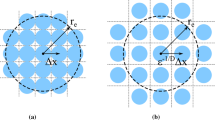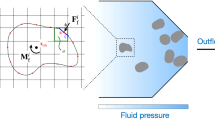Abstract
Particle–fluid and particle–particle interactions can be widely seen in lots of natural and industrial processes. In order to understand these interactions, two-dimensional fluid flowing around and through nine porous particles was studied in this paper based on the lattice Boltzmann method due to its simplicity. Uniform spatial distribution and random spatial distribution were considered and the effects of Reynold number (Re), Darcy number (Da), and the distance between the particles (dx and dy) on the flow characteristics were analyzed in detail. The investigated ranges of the parameters were 10 ≤ Re ≤ 40, 10–6 ≤ Da ≤ 10–2, D ≤ dx ≤ 4D and D ≤ dy ≤ 4D (D is the diameter of the particles). For uniform spatial distribution, it is observed that when dx(dy) increases, the interactions between the particles become weak and the fluid can flow into the spacing between the particles. Besides, the average drag coefficient (CDave) increases with dx(dy) increasing at Re = 20 and the increase rate gradually slows down. Furthermore, the distance change in the direction vertical to inflow direction has more obvious impact on the average drag coefficient. For example, for Re = 20 and Da = 10–4, when dx equals D and dy increases from 2D to 3D, CDave increases by 5.79%; when dy equals D and dx increases from 2D to 3D, CDave increases by 2.61%.

















Similar content being viewed by others
References
Chen RC, Wu JL (2000) The flow characteristics between two interactive spheres. Chem Eng Sci 55(6):1143–1158
Tritton DJ (1959) Experiments on the flow past a circular cylinder at low Reynolds numbers. J Fluid Mech 6(4):547–567
Bhattacharyya S, Dhinakaran S, Khalili A (2006) Fluid motion around and through a porous cylinder. Chem Eng Sci 61(13):4451–4461
Dalman MT, Merkin JH, McGreavy C (1986) Fluid flow and heat transfer past two spheres in a cylindrical tube. Comput Fluids 14(3):267–281
Folkersma R, Stein HN, van de Vosse FN (2000) Hydrodynamic interactions between two identical spheres held fixed side by side against a uniform stream directed perpendicular to the line connecting the spheres’ centres. Int J Multiph Flow 26(5):877–887
He X, Doolen G (1997) Lattice Boltzmann method on curvilinear coordinates system: flow around a circular cylinder. J Comput Phys 134(2):306–315
Hsu JP, Yeh SJ (2009) Translation of two rigid spheres perpendicular to their line-of-centers and normal to a plate. Powder Technol 194(1–2):10–17
Jin H et al (2019) Numerical investigation on drag coefficient and flow characteristics of two biomass spherical particles in supercritical water. Renew Energy 138:11–17
Niu XD et al (2006) A momentum exchange-based immersed boundary-lattice Boltzmann method for simulating incompressible viscous flows. Phys Lett A 354(3):173–182
Yu P et al (2011) Steady flow around and through a permeable circular cylinder. Comput Fluids 42(1):1–12
O’Brien TJ, Syamlal M (1993) Particle cluster effects in the numerical simulation of a circulating fluidized bed. In: Avidan A (ed) Circulating fluidized bed technology IV, Hidden Valley, 1993. AIChE, New York, pp 345–350
Sandeep KP, Zuritz CA (1996) Drag on multiple sphere assemblies suspended in non-newtonian tube flow. Blackwell Publishing Ltd, Oxford, pp 171–183
Beetstra R, van der Hoef MA, Kuipers JAM (2006) A lattice-Boltzmann simulation study of the drag coefficient of clusters of spheres. Comput Fluids 35(8–9):966–970
Shah MT et al (2013) Effect of a cluster on gas–solid drag from lattice Boltzmann simulations. Chem Eng Sci 102:365–372
Wei X, Weber J, Breault RW (2021) Numerical investigation of the penetrating gas flow into particle clusters for circulating fluidized beds. Powder Technol 388:442–449
Rong FM et al (2011) Numerical simulation of the flow around a porous covering square cylinder in a channel via lattice Boltzmann method. Int J Numer Meth Fluids 65(10):1217–1230
Tang Y, Liu H (2017) Modeling multidimensional and multispecies biofilms in porous media. Biotechnol Bioeng 114(8):1679–1687
Nithiarasu P, Seetharamu KN, Sundararajan T (1997) Natural convective heat transfer in a fluid saturated variable porosity medium. Int J Heat Mass Transf 40(16):3955–3967
Wang L et al (2015) Volume-averaged macroscopic equation for fluid flow in moving porous media. Int J Heat Mass Transf 82:357–368
Qian YH, d’humières D, Lallemand P (1992) Lattice BGK models for Navier-Stokes equation. Europhys Lett 6(17):479–484
Nield DA, Bejan A (2006) Convection in porous media
Ladd AJC (1994) Numerical simulations of particulate suspensions via a discretized Boltzmann equation. Part 1. Theoretical foundation. J Fluid Mech 271:285–309
Acknowledgements
This work is supported by the National Natural Science Foundation of China (51922086).
Author information
Authors and Affiliations
Corresponding author
Ethics declarations
Conflict of interest
The authors declare that there is no conflict of interests.
Additional information
Publisher's Note
Springer Nature remains neutral with regard to jurisdictional claims in published maps and institutional affiliations.
Rights and permissions
About this article
Cite this article
Zhang, M., Jin, H. & Shen, S. Numerical simulation of the flow characteristics around and through multiple porous particles. Comp. Part. Mech. 10, 519–531 (2023). https://doi.org/10.1007/s40571-022-00482-w
Received:
Revised:
Accepted:
Published:
Issue Date:
DOI: https://doi.org/10.1007/s40571-022-00482-w




